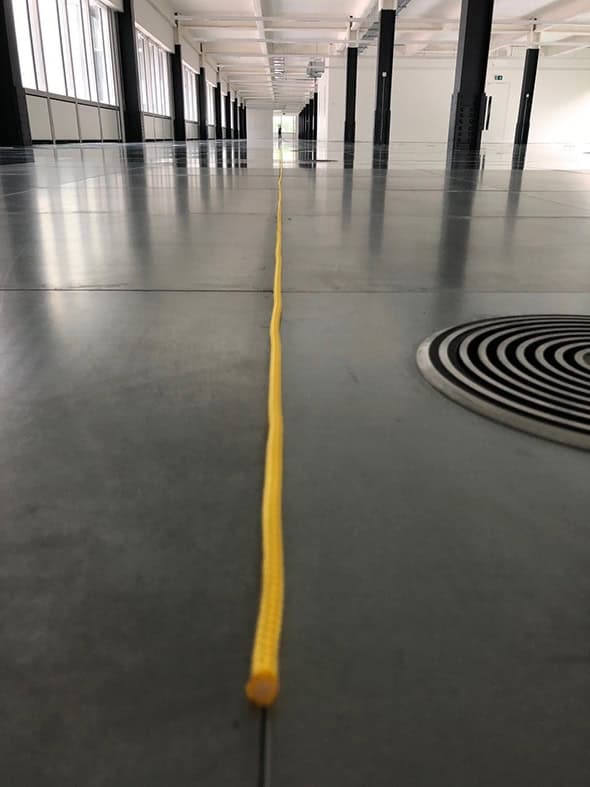Angela Woodhouse and Caroline Broadhead: Surface Tension & (de)figured
Posted: July 1st, 2019 | Author: Caterina Albano | Filed under: Exhibition, Installation, Performance | Tags: Alice Labant, Angela Woodhouse, Caroline Broadhead, Dora House, Marsden Woo Gallery, Martina Conti, Nathaniel Rackowe, Nic Sandiland | Comments Off on Angela Woodhouse and Caroline Broadhead: Surface Tension & (de)figuredCaroline Broadhead and Angela Woodhouse, Surface Tension & (de)figured, June 28

By evincing the intelligence underpinning the process of formal and conceptual exploration, two recent projects by choreographer Angela Woodhouse fit into and exceed the Oxford English Dictionary’s definition of ‘collaboration’ as ‘the action of working together with someone to produce something’. Thermal Duets is a series of five choreographic videos shot with a thermal camera and developed with Nic Sandiland and artist Caroline Broadhead as part of the latter’s exhibition Surface Tension at Mardsen Woo Gallery, while (de)figured is ‘a series of live action drawings by dancers’ created with sculptor Nathaniel Rackowe and dancers Martina Conti and Alice Labant presented in and around Dora House, home of the Royal Society of Sculptors in South Kensington.
Broadhead’s practice brings together fine and applied arts through her expertise in jewellery design. In Surface Tension she rearticulates the relation between material and form by re-creating domestic objects and furniture. An antique picture frame is carefully pulled apart and remounted as a soft, almost articulated necklace that has lost its capacity to hold; a chair is encrusted in a fine silvery chain mail and another has its seat replaced with a geometric pattern of threads; a stool stands precariously on pointed feet while its finely beaded cast lies beside it like the divested skin of an eighteenth-century écorché. In stripping furniture of its functionality, Broadhead draws attention to its intimate relation to the body alluded to in the naming of its constituent parts — head, neck, back, arm, leg, and foot — and in the signs of wear that bear the shape of the bodies that have used them (what nineteenth century dressmakers used to call ‘memories’). Woodhouses’s series Thermal Duets resonates with this investigation of form, material and functionality. The technology of thermal photography was developed for military and surveillance purposes but is here transposed in an intimate context of choreographic stillness and minute movement. The videos are displayed on I-phones in black frames that draw the visitor close as if to a miniature watercolour or embroidery. We see the diaphanous blue and yellow silhouettes of two dancers in each frame while the body heat is revealed in shades of red. A description by John Berger comes to mind: ‘The bodies of dancers with their kind of devotion are dual…A kind of Uncertainty Principle determines them; instead of being alternately particle and wave, their bodies are ultimately giver and gift.’ The intensity and overlaying of colours makes the proximity and interaction of the bodies tangible: the lingering warmth of a hand caressing a back, an arm delicately moving away, or the intense vibration of breath as two heads folds towards each and then separate. Affect is here a residue of presence, a memory of touch. Woodhouse and Broadhead’s use of the thermal camera has transposed Berger’s view into luminous traces of orange-red dance.
The live action drawings of (de)figured are no less an exploration of surfaces, materials and physicality but on a three-dimensional scale. Rackowe’s choice of portable construction-site materials — breeze blocks, yellow scaffolding nets and ropes — relates the impermanent nature of the work and its re-configuration for different sites to the perceived permanence and solidity of buildings, teasing the porous relations between interior and exterior, rigid and pliant. The performance starts on the pavement of Onslow Gardens across the road from Dora House. Slowly unrolling a carefully measured yellow rope Conti walks backwards towards the Old Brompton Road with a serene calculation that contrasts with the bustle of passersby and the congested traffic. Across the road, Labant wraps herself enigmatically inside a scaffolding net hanging down over the entrance portico. The affect of the perceptive and emotional interchange between bodies and environment is central to (de)figured, though here plasticity and weight gain prominence. The yellow rope on the pavement remains as a trace of the initial action that, after Conti’s negotiated hiatus crossing the road, quietly moves indoors with Labant unrolling a black rope from the pavement up the broad entrance steps into the reception area, threading it around breezeblocks in the hall and two adjacent rooms into what was once the studio of court photographers, Elliot and Fry. The meditative pace of Woodhouse’s choreographic movement, like a silent line-drawing, figuratively conflates durability and transience, contrasting the solidity of walls and interior surfaces with the pliability of bodies and soft materials. (de)figured dematerializes in the shadows of the dancers’ bodies projected by industrial lamps on to a wall of the studio. Between them hangs Barbara Hepworth’s Construction 1 (part of the gallery’s current exhibition), taking the notion of collaboration to another level.